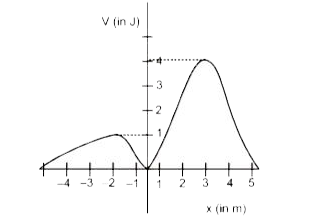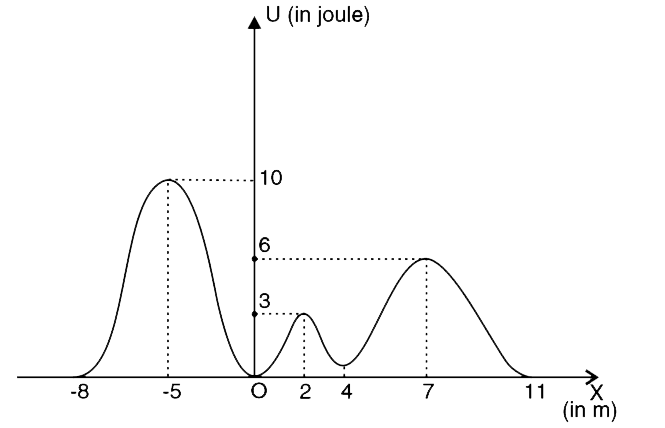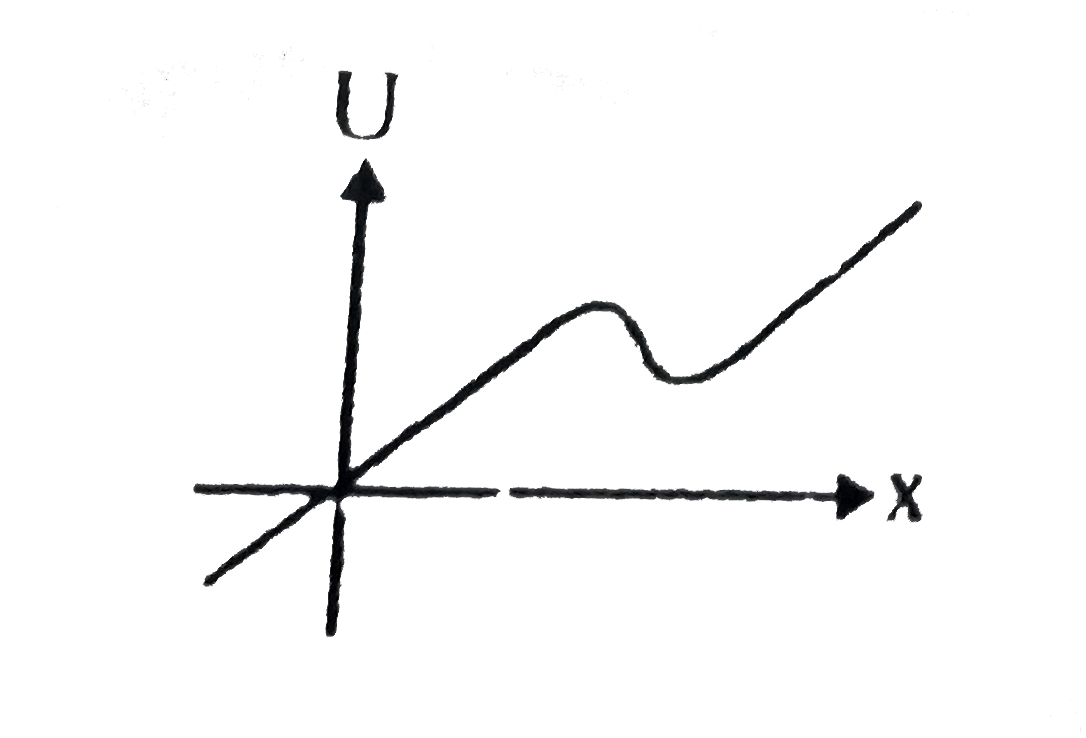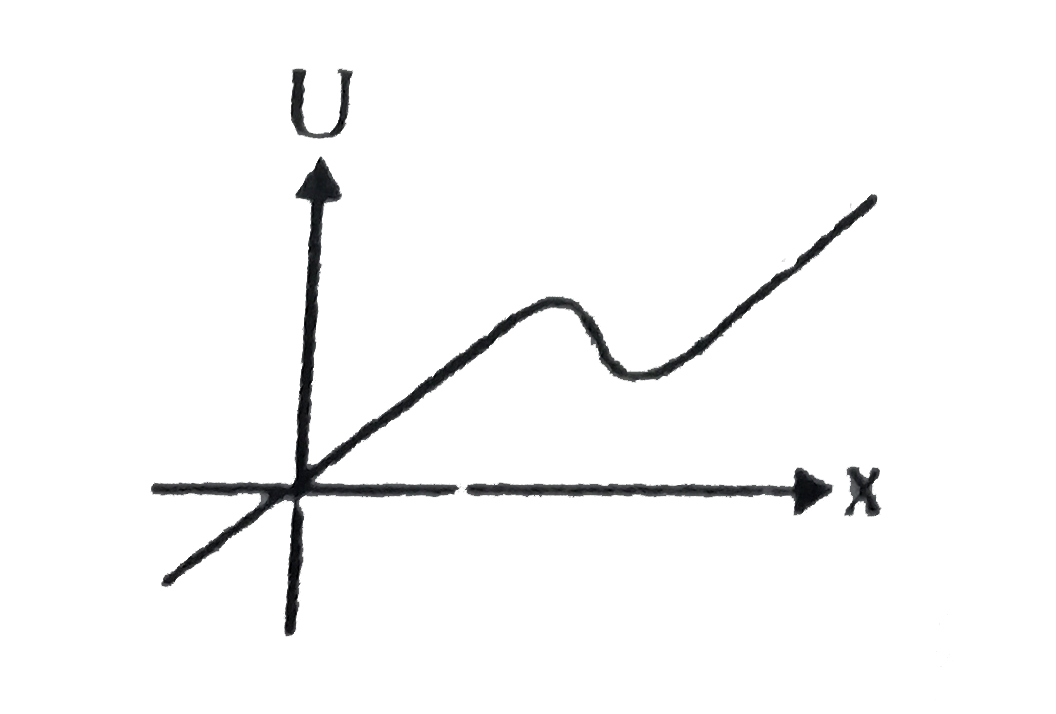A point particle of mass 0.5 kg is moving along the x-axis under a force described by the potential energy V shown below. It is projected towards the right from the origin with a speed v. What is the minimum value of v for which the particle will escape infinitely fasr away from the origin ?

2√2ms−1
2ms−1
4ms−1
The particle will never escape
The correct Answer is:A
12mv2+0=0+2⇒v=2√2m/s
Topper's Solved these Questions
- GRAVITATIONBOOK - ERRORLESSCHAPTER - GRAVITATIONEXERCISE - NCERT BASED QUESTIONS (Motion of Satellite)
46 Videos
- GRAVITATIONBOOK - ERRORLESSCHAPTER - GRAVITATIONEXERCISE - NCERT BASED QUESTIONS (Kepler’s Laws of Planetary Motion)
27 Videos
- GRAVITATIONBOOK - ERRORLESSCHAPTER - GRAVITATIONEXERCISE - NCERT BASED QUESTIONS (Acceleration Due to Gravity)
39 Videos
- FRICTION BOOK - ERRORLESSCHAPTER - FRICTION EXERCISE - ASSERTION & REASON
8 Videos
- KINETIC THEORY OF GASES BOOK - ERRORLESSCHAPTER - KINETIC THEORY OF GASES EXERCISE - ASSERTION AND REASON
16 Videos
Similar Questions
A particle of mass m = 1.0 kg is free to move along the x axis. It is acted upon by a force which is described by the potential energy function represented in the graph below. The particle is projected towards left with a speed v, from the origin. Find minimum value of v for which the particle will escape far away from the origin.

View SolutionA particle of mass 1.5 kg moves along x-axis in a conservative force field. Its potential energy is given by V(x)=2x3−9x2+12x, where all quantities are written in SI units. The plot of this potential energy is given below.
 It is seen that the particle can be in stable equilibrium at a point on x-axis, x_(0). When it is displaced slightly from this equilibrium position, It executes SHM with time period T. What is the value of x0 ?
It is seen that the particle can be in stable equilibrium at a point on x-axis, x_(0). When it is displaced slightly from this equilibrium position, It executes SHM with time period T. What is the value of x0 ?
View Solution
Knowledge Check
A uniform magnetic field B=B0ˆj exists in space. A particle of mass m and charge q is projected towards X-axis with speed v from a point (a,0, 0). The maximum value of v for which the particle does not hit the Y-Z plane is
ABqamBBqa2mCBqamDBq2amA uniform magnetic field B=B0ˆj exists in space. A particle of mass m and charge q is projected towards X-axis with speed v from a point (a,0, 0). The maximum value of v for which the particle does not hit the Y-Z plane is
A2BqdmBBqdmCBq2dmDBqd2mA particle of mass m=5kg is moving with a uniform speed v=3√2 in the XOY plane along the line Y=X+4. The magnitude of the angular momentum of the particle about the origin is
A60 unitB40√2 unitCzeroD7.5 unit
A particle of mass 1.5 kg moves along x-axis in a conservative force field. Its potential energy is given by V(x)=2x3−9x2+12x, where all quantities are written in SI units. The plot of this potential energy is given below.
 It is seen that the particle can be in stable equilibrium at a point on x-axis, x_(0). When it is displaced slightly from this equilibrium position, It executes SHM with time period T. What is the time period of SHM mentioned in the paragraph?
It is seen that the particle can be in stable equilibrium at a point on x-axis, x_(0). When it is displaced slightly from this equilibrium position, It executes SHM with time period T. What is the time period of SHM mentioned in the paragraph?
View SolutionA particle of mass m=5 unit is moving with a uniform speed v=3√2 unit in the XOY plane along the line y=x+4 the magnitude of the angular momentum of the particle about the origin is
View SolutionA particle of mass m=5 unit is moving with a uniform speed v=3√2 unit in the XOY plane along the line y=x+4 the magnitude of the angular momentum of the particle about the origin is
View SolutionA particle is projected with velocity V0along axis x . The deceleration on the particle is proportional to the square of the distance from the origin i.e., a=ωx2.distance at which the particle stops is
View SolutionA particle of mass m moves on positive x-axis under the influence of force acting towards the origin given by −kx2ˆi. If the particle starts from rest at x=a, the speed it will attain when it crosses the origin is
View Solution
